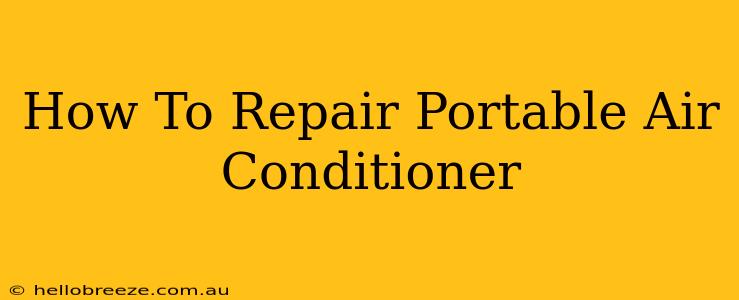Summer heat got you down? A malfunctioning portable air conditioner can quickly turn a comfortable home into a sweltering sauna. Before you call a costly repair service, let's explore some common portable AC problems and how to fix them yourself. This guide will walk you through troubleshooting and simple repairs, saving you time and money.
Common Portable Air Conditioner Problems & Solutions
Portable air conditioners, while convenient, are susceptible to a few common issues. Let's tackle some of the most frequent problems:
1. No Power:
- Problem: The unit won't turn on at all.
- Troubleshooting:
- Check the power cord: Ensure it's securely plugged into both the unit and the wall outlet. Try a different outlet to rule out a faulty outlet.
- Examine the circuit breaker: A tripped breaker can cut power to your AC. Check your home's breaker box and reset any tripped breakers.
- Inspect the power cord for damage: Look for any visible fraying, cuts, or kinks. A damaged cord needs replacing. Do not attempt repairs on a damaged power cord yourself.
- Check the power button: Make sure the power button on the unit is switched on. Sounds obvious, but it's an easy thing to overlook!
2. Weak or No Cooling:
- Problem: The unit is running but not effectively cooling the room.
- Troubleshooting:
- Check the air filter: A clogged air filter restricts airflow, reducing cooling efficiency. Clean or replace the filter as needed (consult your user manual for instructions).
- Inspect the vents: Make sure the vents are not blocked by furniture, curtains, or other obstructions. Proper airflow is crucial for cooling.
- Examine the exhaust hose: Ensure the exhaust hose is properly connected and isn't kinked or blocked. The hot air needs to escape efficiently.
- Check the refrigerant level: This is more complex and usually requires a professional. Low refrigerant indicates a leak, requiring specialized tools and expertise to repair.
- Condenser coil: A dirty condenser coil reduces cooling efficiency. Carefully clean the coil using a coil cleaning brush or vacuum.
3. Unit is Leaking Water:
- Problem: Water is dripping from the unit or pooling around it.
- Troubleshooting:
- Check the drain hose: The drain hose may be clogged or improperly connected. Clean the hose and ensure it's properly positioned.
- Check the condensate pan: The condensate pan may be overflowing. Empty the pan and inspect it for any cracks or damage.
- Inspect for leaks: Look for any visible leaks in the unit's hoses or connections.
4. Strange Noises:
- Problem: The unit is making unusual noises, like grinding, rattling, or clicking.
- Troubleshooting:
- Identify the source of the noise: Carefully listen to pinpoint where the noise is coming from.
- Check for loose parts: Loose screws or components can cause rattling. Tighten any loose screws or parts.
- Check the fan blades: Make sure the fan blades are not rubbing against anything.
- Compressor issues: Unusual noises could indicate a problem with the compressor. This usually requires professional repair.
When to Call a Professional
While many minor repairs are manageable at home, some problems require the expertise of a qualified technician. Call a professional if:
- You suspect a refrigerant leak.
- The compressor is malfunctioning.
- You're uncomfortable performing any of the troubleshooting steps.
- The problem persists after attempting the troubleshooting steps above.
By following these simple troubleshooting steps, you can often resolve common portable air conditioner problems and enjoy cool comfort throughout the summer. Remember safety first! If you are unsure about any repair, it's always best to call a qualified HVAC technician.

